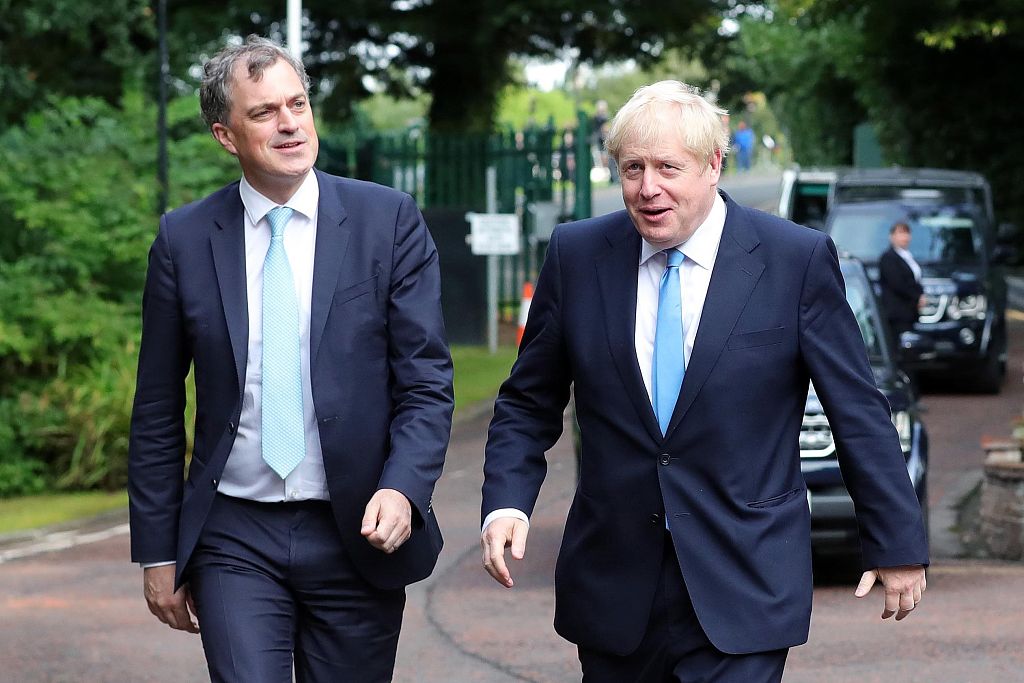
Britain's Northern Ireland Secretary Julian Smith (L) and Britain's Prime Minister Boris Johnson arrive at Stormont House, Belfast for talks on July 31, 2019. (Photo: VCG)
British Prime Minister Boris Johnson on Wednesday visited Northern Ireland, the key battleground in Brexit and the focus of increasingly tense rhetoric on both sides of the Irish Sea.
He arrived in Belfast on Tuesday amid warnings from Irish leaders that his vow to leave the European Union, with or without a deal, risks breaking up the United Kingdom.
Those warnings continued on Wednesday.
But during meetings with the province's main political parties he reiterated his determination to split with the EU.
"The Prime Minister made clear that the UK would be leaving the EU on October 31st come what may," a Downing Street spokesperson said.
After meeting Johnson, Mary Lou McDonald, the head of Republican Sinn Fein party, said he had "set the compass for a disorderly and a crash Brexit," meaning that there had now to be the opportunity for Northern Ireland to consider joining the Republic.
"We've made it clear to him that the extensive planning that he tells us he is carrying out in respect of a crash Brexit has to include the constitutional question," she told the BBC.
- The backstop -
The Republic of Ireland shares a land border with the province that both sides want to keep free-flowing after Brexit, both for economic reasons and to maintain the delicate peace deal that brought an end to decades of violence between the pro-Irish and pro-British communities.
But post-Brexit, that border will become part of the EU's external frontier and would legally require policing.
The agreement struck by Johnson's predecessor Theresa May proposed the so-called "backstop" solution after Brexit.
But eurosceptics believe it gives the EU too much control over the UK and risks constitutionally distancing Northern Ireland from Britain.
If a trade deal cannot be agreed by the end of 2020, under the backstop the UK would remain aligned with the EU customs union, while Northern Ireland would additionally stay aligned to some European single market rules, in order to keep the Irish border free-flowing.
Neither London nor Brussels can end the arrangement unilaterally.
- A united Ireland? -
On Tuesday, Johnson told Irish Prime Minister Leo Varadkar that the "backstop" plan was unacceptable, putting him at odds with both Dublin and Brussels, which insist the deal is not open for renegotiation.
"If they really can't do it then clearly we have to get ready for a no-deal exit," Johnson said on a trip to Wales, adding: "It's up to the EU: this is their call."
Varadkar has said previously that Johnson's plan to renegotiate the deal by October 31 was "totally not in the real world".
Leaving without a deal would throw the border status into confusion and threaten economic catastrophe for Ireland, cutting it off from its UK main trading partner.
Varadkar said on Friday that a no-deal Brexit would make the unification of Northern Ireland and the Republic of Ireland more likely.
"People who you might describe as moderate nationalists or moderate Catholics who were more or less happy with the status quo will look more towards a united Ireland," he said.
Northern Ireland is not the only part of the United Kingdom whose status after Brexit is under the spotlight.
Johnson visited Scotland on Monday, where First Minister Nicola Sturgeon said last week that Scotland needed an "alternative option" to his Brexit strategy.
In Wales, First Minister Mark Drakeford told him that Brexit would be "catastrophic" and to "stop playing fast and loose with our country".


